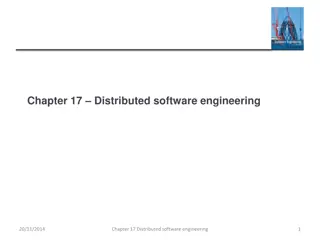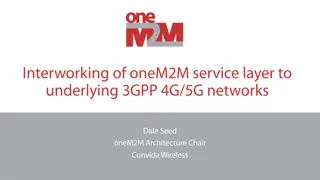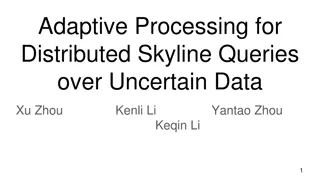Data Fragmentation in Distributed Systems
Data fragmentation is a key aspect in distributed database systems, involving splitting relationships into logical parts for parallel query execution. Learn about horizontal fragmentation types such as primary, derived, complete, and disjoint. Explore primary horizontal fragmentation rules and computing methods to enhance database efficiency.
Download Presentation

Please find below an Image/Link to download the presentation.
The content on the website is provided AS IS for your information and personal use only. It may not be sold, licensed, or shared on other websites without obtaining consent from the author.If you encounter any issues during the download, it is possible that the publisher has removed the file from their server.
You are allowed to download the files provided on this website for personal or commercial use, subject to the condition that they are used lawfully. All files are the property of their respective owners.
The content on the website is provided AS IS for your information and personal use only. It may not be sold, licensed, or shared on other websites without obtaining consent from the author.
E N D
Presentation Transcript
PRIMARY HORIZONTAL FRAGMENTATION PRESENTATION ID: 9 KIRTI (1550820)
CONTENTS What is data fragmentation? Types of fragmentation in Distributed system. Horizontal fragmentation and its types. Primary Horizontal Fragmentation Computing Horizontal Fragmentation Rules for horizontal fragmentation.
WHAT IS DATA FRAGMENTATION? It is splitting of a relationship into logically related and correct parts. Fragmentation is one of the important feature of distributed database system. These fragments could be stored at different locations and allows the parallel execution of a query. The fragmentation should be carried out in such a way that the reconstruction of original database from the fragments is possible. A relation can be fragmented in three ways: 1. Horizontal fragmentation 2. Vertical fragmentation 3. Mixed/ Hybrid fragmentation
HORIZONTAL FRAGMENTATION AND ITS TYPES Horizontal fragmentation is splitting of tables horizontally that is into tuples or rows to create subsets of tables. Only the rows splits in case of horizontal fragmentation. Types of horizontal fragmentation: 1. Primary Horizontal Fragmentation 2. Derived Horizontal Fragmentation 3. Complete Horizontal Fragmentation 4. Disjoint Horizontal Fragmentation
PRIMARY HORIZONTAL FRAGMENTATION Primary horizontal fragmentation is the process of fragmenting a single table, row wise using a set of conditions. For example, consider fragmentation of PROJ relation given below: PROJ1: projects with budgets less than 200, 000 Fragmentation 1
PRIMARY HORIZONTAL FRAGMENTATION CONT.. PROJ2: projects with budgets greater than or equal to 200, 000 Fragmentation 2 For horizontal fragmentation, every site should hold all information that is used to query at the site in form of fragments so that the queries of the site run faster Horizontal fragmentation is defined as selection operation, p(R)
COMPUTING HORIZONTAL FRAGMENTATION Example: BUDGET <200000 (PROJ) BUDGET 200000 (PROJ) Compute the frequency of the individual queries of the site q1, . . . , qQ The queries of the site should be reviewed in form of conjunctions. These are called minterms. Now, compute the selectivity of the minterms. Find the minimal and complete set of minterms (predicates) . The set of predicates is complete if and only if any two tuples in the same fragment are referenced with the same statistics by any application.
COMPUTING HORIZONTAL FRAGMENTATION CONT.. The set of predicates is minimal if and only if there is at least one query that accesses the fragment . The algorithm used for this purpose are CON MIN and PHORIZONTAL. In most cases of horizontal partitions if suppose { t 1, t 2, t 3 }, { t 4, t 5 }, and { t 2, t 3, t 4, t 5 } be query results. Then tuples fragmentation would be in the following way:
RULES FOR HORIZONTAL FRAGMENTATION Completeness Decomposition of relation R into fragments R 1, R 2, . . . , R n is complete iff each data item in R can also be found in some R i . Reconstruction If relation R is decomposed into fragments R 1, R 2, . . . , R n, then there should exist some relational operator that reconstructs R from its fragments. Union is used to combine horizontal fragments. Disjointness If relation R is decomposed into fragments R 1, R 2, . . . , R n and data item d i appears in fragment Rj , then d i should not appear in any other fragment R k, k 6= j For horizontal fragmentation, data item is a tuple. For vertical fragmentation, data item is an attribute























